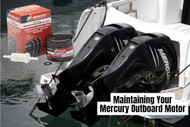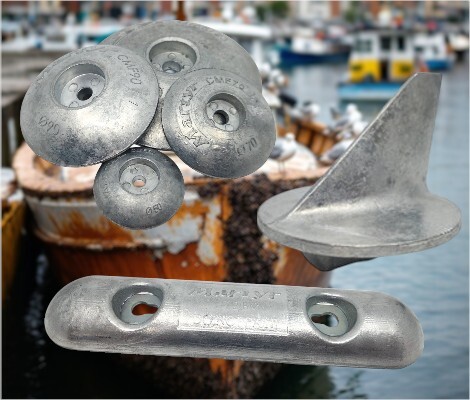Best Practices for Maintaining Your Mercury Outboard Motor
10th Aug 2025
Your Mercury outboard motor is a reliable and powerful piece of equipment, but like any marine engine, it requires regular care to perform at its best. Proper maintenance not only extends the life of your motor but also ensures safety and efficiency when you’re on the water. In this guide, we’ll cover the essential steps to keep your Mercury outboard in top condition.
1. Follow the Manufacturer’s Service Schedule
Always refer to Mercury Marine’s official service guidelines. Regular inspections, oil changes, and part replacements should be completed according to the recommended intervals to avoid unexpected breakdowns.
2. Check and Change Engine Oil
For four-stroke Mercury outboards, changing the engine oil at least once per season (or every 100 hours) is crucial. Always use the oil grade specified in your owner’s manual, and replace the oil filter at the same time. - See Genuine Mercury 4 Stroke Oil here.
3. Inspect and Replace Spark Plugs
Spark plugs play a critical role in fuel combustion. Check them for fouling, wear, or corrosion, and replace them as needed. Using the correct plug type and gap setting will ensure optimal performance. - See common Verado spark plug here.
4. Maintain the Cooling System
Flush the engine with fresh water after every trip, especially if you’ve been in saltwater. This prevents salt and mineral buildup in the cooling passages. Inspect the water pump impeller regularly and replace it if worn or damaged. - See Mercury outboard flusher here.
5. Fuel System Care
Always use fresh fuel and add a marine-specific fuel stabiliser if the motor will be stored for an extended period. Replace fuel filters and water-separating filters as part of regular service. - See Sierra fuel treatment here.
6. Battery Maintenance
Ensure the battery is fully charged and the terminals are clean and corrosion-free. Disconnect the battery during long storage periods to prevent drainage.
7. Store Your Outboard Properly
When not in use, store your Mercury outboard in an upright position. For longer-term storage, follow the manufacturer’s winterisation procedures, including fogging the engine.
8. Keep an Eye on Propeller Condition
Your Mercury outboard’s propeller directly affects performance and fuel efficiency. Inspect it for dings, cracks, or bent blades, as even minor damage can reduce speed and cause vibration. Remove the propeller periodically to check for fishing line or debris wrapped around the prop shaft, and apply a light coating of marine grease before reinstalling. - Need a new prop? We have you covered.
9. Monitor Engine Mounts and Steering Components
Loose or worn engine mounts can lead to poor handling and vibration. Regularly inspect all bolts, brackets, and bushings for signs of wear. Steering cables should move smoothly without stiffness—apply marine-grade lubricant to pivot points and grease fittings as needed. - See Mercury 2-4-C grease here.
10. Pay Attention to Warning Systems
Modern Mercury outboards have built-in alarms for temperature, oil pressure, and other key functions. Familiarise yourself with these warning indicators so you can take immediate action if something goes wrong. Ignoring warning lights or sounds could lead to costly repairs.
11. Keep Your Outboard Clean
Regularly washing your outboard with fresh water and mild soap helps prevent salt, dirt, and grime from building up. Apply a marine-safe protectant spray to external surfaces to guard against UV damage and corrosion. A clean motor is easier to inspect for leaks, cracks, or loose parts.
12. Record All Maintenance Activities
Keep a logbook of all services, part replacements, and inspections. This helps track performance over time, ensures you don’t miss scheduled maintenance, and can increase resale value when it’s time to upgrade.
For genuine parts and maintenance kits, visit our Mercury Outboard Parts page.
Refer to the official Mercury Marine Maintenance Resources for detailed manufacturer recommendations.
FAQs
Q1: How often should I service my Mercury outboard motor?
A: At least once a year or every 100 hours of operation, whichever comes first.
Q2: What’s the most important maintenance step for saltwater use?
A: Always flush the engine with fresh water after each trip to prevent corrosion and salt buildup.
Q3: Can I use automotive oil in my Mercury outboard?
A: No. Always use marine-grade oil that meets Mercury’s specifications.
Q4: How often should I service my Mercury outboard motor?
A: Mercury recommends following the service intervals outlined in your owner’s manual—typically every 100 hours of use or annually, whichever comes first. More frequent servicing may be needed in harsh marine environments.
Q5: Can I flush my Mercury outboard while it’s still in the water?
A: Yes, many Mercury models allow flushing with a built-in flushing port, but it’s best to check your specific model’s instructions to ensure correct procedure and avoid water entering unwanted areas.
Q6: What type of fuel is best for a Mercury outboard motor?
A: Use fresh, clean unleaded petrol with a minimum octane rating recommended in your manual. Avoid ethanol blends above 10% as they can damage internal engine components.
Q7: How do I know if my propeller needs replacing?
A: Signs include reduced top speed, increased fuel consumption, vibration, or visible damage like bent or chipped blades. A damaged propeller can impact engine performance and should be addressed immediately.
Q8: Should I disconnect the battery when storing my outboard motor?
A: Yes, disconnecting the battery during long-term storage helps prevent drain and potential electrical issues. Store the battery in a cool, dry place and recharge it periodically.

 Australian Dollars
Australian Dollars


